by K.G. Beck * (Revised 12/13)
Quick Facts…
- Prevention, eradication, and control are three general management strategies.
- Prevention is the first line of defense to keep weeds from occurring or increasing.
- Eradication is the removal of weeds from an area so they will not recur unless reintroduced.
- Control reduces a weed population to a level where you can make a living off of or enjoy using the land.
- A weed management system integrates two or more methods into a plan of operation.
Prevention
Prevention is the first line of defense and keeps weeds from occurring or increasing in an area. Preventive techniques include planting high quality, weed-seed-free crops or grass seed. Legislative items, such as clean-seed acts and weed-management laws, also can help stop weed problems before they occur or may deter weed spread. Controlling existing infestations so they do not increase in size also is an important preventive measure.
An important preventive measure related to control is to keep weeds from going to seed. This is important for annuals and biennials, because that is the only way they reproduce. Perennials reproduce from seed, as well as vegetatively from their root systems. Annual weeds live for one growing season, biennials for two and perennials more than two. However, preventing seed set is extremely important to keep perennials from starting new infestations some distance from existing ones.
Eradication
Eradication is the removal of weeds from an area so they will not recur unless reintroduced. If eradication creates an open area, one weed problem may be cured simply to create another one. If eradication is necessary, revegetate the ground to prevent another weed infestation. Eradication is desirable for small patches, 10 to 100 feet in diameter, but not always for larger ones.
Control
Control, the most common management strategy, reduces a weed population to a level where you can make a living off of or enjoy using the land. Adequate control also may prevent future infestations. There are four control methods: cultural, mechanical, biological and chemical.
Cultural control methods promote growth of desirable plants. Seeding is the most commonly used cultural control method and must be combined with control methods that decrease the target weed population and gives the seeded species an opening in the environment to successfully germinate and establish (colonize). The USDA-Natural Resource Conservation Service is an outstanding source of information as to what species to plant in a particular area and at what rate. Fertilization, irrigation and planting at optimum densities let crops compete with weeds and not with each other. While nitrogen fertilization increases yields in grass hay meadows, it also fosters weed establishment and growth. Fertilize cautiously, especially with nitrogen, and only when necessary as determined by soil testing.
Mechanical control methods physically disrupt weed growth. This is the oldest control method and is used most often worldwide. Tillage, hoeing, hand-pulling, mowing and burning are examples. To mulch or smother weeds often is considered mechanical, even though it simply excludes light rather than physically disrupting weed growth.
Biological control methods use an organism to disrupt weed growth. Often the organism is an insect or disease and a natural enemy of the weed. This is called classical biological control. Classical is not the only form of biological control. Livestock can be effective weed-management tools if managed correctly. However, improper livestock management (overgrazing) can be extremely damaging to the environment and exacerbate weed problems.
Chemical control methods use herbicides to disrupt weed growth. The first rule of any pesticide use is to read the label before using the product and follow all directions and precautions. (NOTE: Avoid using soil-active herbicides, such as Tordon, Banvel/Vanquish/Clarity, Perspective, or Telar, near windbreak plantings and other desirable woody vegetation. Plant injury or death can occur. Do not allow any herbicide to drift onto woody or other desirable vegetation for the same reason.)
Weed Management Systems
A weed management system uses two or more control methods. The key is to encourage desirable plant growth with optimum fertilization, when necessary, and/or irrigation (cultural control) where applicable. Plant competition is an often overlooked tool and should be used first, but not exclusively. When enhancement of the desirable plant community is necessary, make sure you seed at optimum rates to ensure establishment and subsequent competition with weeds. Generally, perennial, sod-forming grasses compete best with weeds.
Till, hoe, hand-pull, mow or mulch (mechanical control) if desired. Herbicides (chemical control) are powerful tools that should be used judiciously, not exclusively. Herbicides may be a component of the weed-management system. Biological controls can also be part of a system. Several natural enemies currently are available from the Colorado Department of Agriculture. Livestock grazing can be effective, depending on the weed species, if the livestock are properly managed for weed control.
Canada Thistle
Colorado State University research shows that under habitat conditions where the root growth of Canada thistle may be restricted, such as high water tables, mowing is advantageous. Mow Canada thistle (Figures 1 and 2) to 2 to 4 inches during the growing season to stress plants and prevent seed formation. Mow monthly, starting at bolt to early bud-growth stage (approximately mid-June). Alternatively, till at three-week intervals. Tillage or mowing during the growing season sets up the weed for fall herbicide treatments. Tillage or mowing stresses Canada thistle and forces it to draw upon stored root nutrients. The key to controlling Canada thistle and other perennials is to exhaust root nutrient stores, regardless of the control procedure used.
Allow Canada thistle to recover (cease mowing or tillage) in mid-August so ample foliage is present in fall to intercept herbicides. Some plants may recover to flower in the fall, so apply a herbicide before this occurs. Treat the infestation with Tordon at 1 quart per acre (A), Milestone at 7 fluid ounces/A, Curtail at 3 quarts/A, Vanquish/Clarity at 2 quarts/A, or Telar at 1 ounce/A. Add an agricultural surfactant at 0.25 percent v/v (equivalent to 1 quart of surfactant to 100 gallons of spray solution) to Telar treatments or control will be inadequate.
| Treatment key: /A = per acre; ai/A = active ingredient per acre; v/v = volume per volume. |
Any of these herbicides kill legumes, such as alfalfa or clover. Don’t use Tordon near water, particularly irrigation water. The herbicide can end up in a field other than a grass pasture and injure susceptible crop species or desirable woody vegetation. Consult the Tordon label for precautions or contact your Colorado State University Extension county office.
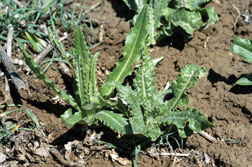 |
Figure 1. Canada thistle rosettes growing from creeping roots in early spring. |
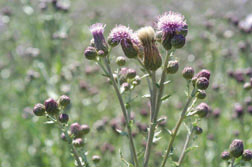 |
Figure 2. Canada thistle flowers and flower buds. |
Sometimes Canada thistle invades grass pastures that are in good condition. In situations where the grass population is adequate, a single management method may be sufficient because plant competition from perennial grasses (cultural control) is already in place.
In this circumstance, a spring application of Milestone at 7 fluid ounces/A, Tordon at 1 quart/A, Telar at 1 ounce/A, or Banvel/Vanquish/Clarity at 2 quarts/A may prove adequate. Apply Banvel/Vanquish/Clarity when Canada thistle is in the rosette-growth stage, Milestone when Canada thistle is in the late bolting or pre-flower-bud growth stage, Telar at the bloom stage, or Tordon any time after the weed has emerged. Alternatively, repeated mowing may, overtime, decrease the Canada thistle population.
Usually reseeding is necessary to fill an open space left by killed thistle and provide competition to thistle that recovers. Perennial grasses may be sown the same season any of these herbicides are used. Dormant seeding is recommended (seed in late fall so grass seed will not germinate and emerge until the following spring). Wait at least 30 days after herbicide application. When necessary, improve fertility in the controlled area to favor grass or other desirable plant growth. Take soil samples to determine nutrient needs and fertilize in fall or the following spring. Remember, nitrogen fertilization favors weed growth so fertilize cautiously.
This system combines mechanical, chemical and cultural control. Canada thistle is difficult to control and may recover. Repeat procedures as necessary.
Leafy Spurge
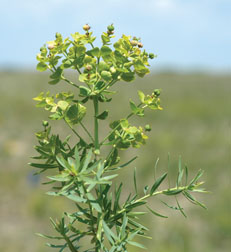 |
Figure 3. Leafy spurge flowering to seed set growth stage. |
Mowing leafy spurge (Figure 3) at 14- to 21-day intervals may cause higher susceptibility to fall-applied herbicides, but there are limited data to support this. Alternatively, sheep or goats can graze leafy spurge. This stresses the weed and relieves grasses from competition so pastures can be used effectively by cattle and horses. Sheep or goat grazing may make leafy spurge more susceptible to fall-applied herbicides. Colorado State research shows that leafy spurge was not more susceptible to fall-applied herbicides when preceded by grazing but research by North Dakota State University suggests the opposite. At a minimum, grazing leafy spurge makes use of the weed and infested ground, may help deter its spread, and in some situations, may reduce its population.
Regardless of the top-growth control method, allow leafy spurge to regrow in mid-August so a good stand is present to receive fall-applied herbicides. Apply Tordon at 1 quart/A, Tordon + 2,4-D at 0.5 to 0.75 + 1 quart/A, Paramount at 16 oz/A, or Plateau at 10 to 12 fl oz/A in fall. Plateau and Paramount must be combined with a methylated seed oil at 1.5 to 2 pt/A or control will be inadequate. Plateau applied in fall often injures cool season grasses but they typically recover by the following growing season. The later in the fall one uses Plateau, the greater the injury to cool season grasses. Conversely, Paramount is one of the most selective herbicides evaluated in CSU field research on native forbs and grasses, but has a relatively narrow spectrum of activity on different weed species. Fertilization, if necessary and as determined by soil sampling, can help grasses compete with stressed leafy spurge.
Leafy spurge is a persistent, hard-to-control weed that often recovers from control attempts. If necessary, repeat the management system after three to four years. Reduced herbicide rates often can be used at that time.
Biological control agents are available from Colorado Department of Agriculture. Four flea beetles (Apthona nigriscutis, black-dot spurge flea beetle; A. flava, copper spurge flea beetle; A. cyparissiae, brown-dot spurge flea beetle; and A. czwalinae, black spurge flea beetle) are being reared and redistributed by the Colorado Department of Agriculture. Their habitat requirements vary. The black-dot spurge flea beetle prefers open (no shade), dry sites with coarse soils low in organic matter. The brown-dot spurge flea beetle prefers soils higher in moisture than the black-dot spurge flea beetle but still prefers open sites with moderately coarse textured soils such as sandy loams. The copper spurge flea beetle does well in coarse soils with high-water tables in open and shaded condition. The black spurge flea beetle prefers moist clay soils. Adult flea beetles feed on leaves but larvae bore into leafy spurge roots, causing the majority of plant damage.
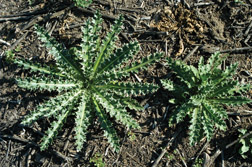 |
Figure 4. Musk thistle rosettes; note cream colored mid-rib and frosted appearance of leaf margins. |
Musk Thistle
Musk thistle (Figure 4, 5, and 6) is a biennial. The key to successful management is to prevent seed formation. Musk thistle occurs in pastures in direct proportion to moisture and sunlight. The weed grows more in pastures in poor condition than those in good condition. Reseeding, once its populations are reduced, may be a necessary final management step to prevent reinfestation by musk thistle.
Cut off the weed below the soil line with a hoe or a shovel before the bud stage or treat the weed in spring or fall with herbicides. Apply Tordon at 0.25 to 0.5 quart/a, Milestone at 3 to 5 fluid ounces/a or Vanquish/Clarity + 2,4-D at 0.5 + 1.0 quart/A to musk thistle rosettes. In spring, treat before musk thistle bolts or it may recover and develop seed, although Milestone may be applied into the bolting growth stage. Apply Telar or Escort at 1 ounce or 0.5 ounce/A, respectively. Add a good agricultural surfactant to the spray mixture at 0.25 percent v/v. Apply in spring when musk thistle is in the rosette- to early-flower growth stages. If treating in early flower, do not allow the pink portion of the developing flower to exceed the size of a dime. Research at Colorado State University indicates little to no viable seed is formed when Telar or Escort are applied during these growth stages.
The musk thistle seedhead weevil (Rhinocyllus conicus) is widespread in Colorado. Larvae of this insect destroy developing seeds but are not 100 percent effective by themselves. Musk thistle has flowers in various growth stages at once and the weevil’s life cycle usually is finished before all flowers develop. Apparently, the weevil typically decreases seed production by about 50 percent. Herbicides can be combined with weevils if the insects are allowed to complete their life cycles. Telar or Escort, applied at early flower in spring or Tordon or Banvel/Vanquish/Clarity + 2,4-D in fall, should allow this. The must thistle seedhead weevil is no longer being distributed in the U.S. because it is not specific to musk thistle and will attack native thistles. The musk thistle rosette weevil (Trichosirocalus horridus) is available from the Colorado Department of Agriculture. Larvae feed on the meristems of rosettes and developing shoots, causing plants to be less vigorous and produce fewer seeds.
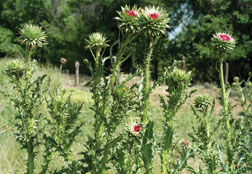 |
 |
|
Figure 5. Musk thistle flower bud growth stage; note large spade-shaped bracts under developing flower. |
Figure 6. Musk thistle flower; note lack of stem leaves beneath flower. |
Diffuse Knapweed
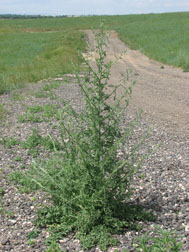 |
Figure 7. Large diffuse knapweed plant. |
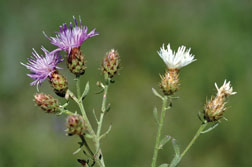 |
Figure 8. Diffuse knapweed flowers; color varies from white to purple; note well-developed fringe on sides of bracts and long terminal spine on bract tip; brack tips can be dark colored. |
Diffuse knapweed (Figure 7 and 8) is a short-lived perennial, biennial, or occasionally an annual. The key to management is to prevent it from going to seed. Diffuse knapweed invades overgrazed pastures, forms dense stands and may be toxic to horses. After a herbicide treatment, reseed a poor-conditioned pasture so grasses can be present to compete with surviving diffuse knapweed and prevent re-invasion by the weed.
Spring- or fall-applied herbicides are effective. Research conducted at Colorado State University indicates Tordon at 1 pint/A, Milestone at 5 to 7 fluid ounces/A, or Banvel/Vanquish/Clarity + 2, 4-D at 0.5 + 1.0 quart/A, applied in spring from rosette to early-bolt growth stages, are effective. Curtail at 2 to 3 quarts/A and Transline at 0.67 to 1 pint/A also readily control diffuse knapweed when applied at the rosette to early-bolting growth stage. Use the higher rate of Milestone, Transline, or Curtail on old or dense stands of diffuse knapweed.
The Colorado Department of Agriculture offers several biological control agents. The knapweed gall flies (Urophora affinis and U. quadrifasciata) are readily available. Females lay eggs in developing flowers. As they feed on heads, the larvae incite gall formation, which reduces seed formation.
The gall fly overwinters inside the seed head as larvae. The normal procedure for redistribution is to cut last year’s dead stand that contain larvae and tie the bouquet to a fence post near knapweed stands. Adults will emerge in spring and repeat the life cycle. Using biocontrol that affects the vegetative growth stage may be most effective to decrease diffuse knapweed populations.
The diffuse knapweed root beetle (Sphenoptera jugoslavica) has been the most successful insect to date in Colorado, but its availability is limited. The knapweed root weevil and Cyphocleonus achates also attacks vegetative growth and is available from the Colorado Department of Agriculture. The knapweed seedhead weevil (Larinus minutus), also available from the Colorado Department of Agriculture, is an extremely aggressive and effective biocontrol insect for diffuse and spotted knapweed. Larvae consume knapweed seeds and up to 100 percent of seeds may be destroyed in an infested seedhead. When larval development is complete, larvae pupate then emerge from the seedhead as adults and consume foliage of diffuse and spotted knapweed until they enter the litter and soil to overwinter.
As with any integrated weed-management system, biocontrol should be combined with seeding of perennial grasses.
*Colorado State University Extension weed science specialist and professor, bioagricultural sciences and pest management.2/00. Revised 12/13.
Colorado State University, U.S. Department of Agriculture, and Colorado counties cooperating. CSU Extension programs are available to all without discrimination. No endorsement of products mentioned is intended nor is criticism implied of products not mentioned.
Go to top of this page.





